1. Salakos – Monastery of Prophet Elias
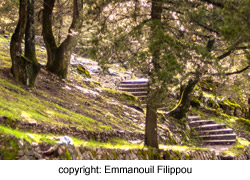 This route is of slight difficulty. The trail is built and begins from a steep face of rock that lies above the village Salakos at an altitude of 220 meters. Here are the sources of high quality water Nymph of Rhodes. The trail ends at the Monastery of Prophet Elias, at an altitude of 610 meters.
This route is of slight difficulty. The trail is built and begins from a steep face of rock that lies above the village Salakos at an altitude of 220 meters. Here are the sources of high quality water Nymph of Rhodes. The trail ends at the Monastery of Prophet Elias, at an altitude of 610 meters.
The route is approximately 650 meters and crossing a landscape with dense vegetation measured 115 species, of which 20 are rare and of unique beauty. Most notable of them grow in the spring, from mid April to mid May. Among the violets and orchids, is as well a rare native wildflower peonia. The vegetation found throughout the years, starting from a rich forest of oaks and shrubs, followed by a smooth ascent among cypress mixed with a few pines.
Here one can encounter the deer of Rhodes, called Platoni or Dama Dama and Hawk Petritis. The area is a wildlife sanctuary and protected from the program Natura 2000. On the way one can enjoy the cool breeze of the mountains and the incomparable sea view.
On the way just before the top one finds another Catholic monastery of the Archangel Michael. At the top, just before the end of the path are two enchanting hotels the “Elafos” and “Elafina” that were built in the 1930’s.
Finally, for the most demanding nature lovers and those keen on walking, there are branches of the pathway. The paths are hidden among the woods leading in turn through to monasteries, sources and glades that will amaze the visitor.
2. The Valley of the Butterflies
(Museum of Natural History – Holy Monastery Kalopetra)
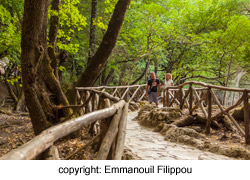 Taking the western road (provincial road Rhodes – Kamiros) and shortly after the village Paradisi one turns left to Psinthos. Before Psinthos is the Butterfly Valley. The route begins at the northern entrance of the Valley where the Museum of Natural History is at an altitude of 150 meters. The path length is 1300 meters and ends at the Holy Monastery of Panagia Kalopetra at an altitude of 470 meters. The trail is organized by bridges, wooden rails and has an entry price which includes a visit to the Museum of Natural History.It is a comfortable and pleasant journey along the verdant valley with small waterfalls and ponds. Hosts known butterflies of Rhodes (Panaxia quadipunctaria), living there by the thousands in the summer from early June to mid September. The Valley is full of them. In the Valley of the Butterflies is the only natural forest in Europe from a species called Ygramvari (Zidia).
Taking the western road (provincial road Rhodes – Kamiros) and shortly after the village Paradisi one turns left to Psinthos. Before Psinthos is the Butterfly Valley. The route begins at the northern entrance of the Valley where the Museum of Natural History is at an altitude of 150 meters. The path length is 1300 meters and ends at the Holy Monastery of Panagia Kalopetra at an altitude of 470 meters. The trail is organized by bridges, wooden rails and has an entry price which includes a visit to the Museum of Natural History.It is a comfortable and pleasant journey along the verdant valley with small waterfalls and ponds. Hosts known butterflies of Rhodes (Panaxia quadipunctaria), living there by the thousands in the summer from early June to mid September. The Valley is full of them. In the Valley of the Butterflies is the only natural forest in Europe from a species called Ygramvari (Zidia).
3. Holy Monastery of Panagia Tsambika
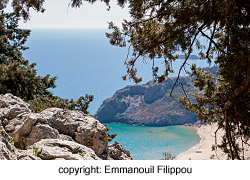 From the eastern road (national road Rhodes – Lindos) before the village of Archangelos and the point where a sign indicating to the left ” Panagia Tsambika ” begins a paved road with many turns of about 1200 meters, and ends in a square.
From the eastern road (national road Rhodes – Lindos) before the village of Archangelos and the point where a sign indicating to the left ” Panagia Tsambika ” begins a paved road with many turns of about 1200 meters, and ends in a square.
From there begins to the tip of the steep slope, a winding path consisting of 297 steps. Passing through a magnificent forest of cypress mixed with a few pine trees germinated on the rocky ground on the top where is the church of Panagia Tsambika “Psili”, at an altitude of 320 meters.
The panoramic view of the surrounding area and the atmosphere of the monastery, will compensate the visitor the small in length but steep climb. The return is along the same route.
4. Coastal path Rhodes – Kritika (Kato Petres)
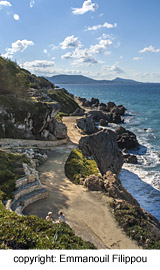 The trail begins at the southern end of the beach Psaropoula at the entrance to the city of Rhodes and ends at the northern end of the bay of Ialysos where the Kritika village starts.
The trail begins at the southern end of the beach Psaropoula at the entrance to the city of Rhodes and ends at the northern end of the bay of Ialysos where the Kritika village starts.
After walking in the sand 300 meters begins the path that is earthy, with a small stones in some spots. Length is approximately 1800 meters and a width of 2.5 meters. The sea lies to the west and on the east rises a steep slope. Throughout the route there are stone benches and small auditoriums where one can relax and enjoy the cool sea breeze and the sunset. Also there are steps that lead to non-organized beach though mostly rocky, ideal for swimming. Some other steps leading to the main road along the trail.
The trail is well organized, with elegant stone walls and wooden railings that protect the stroller from any danger. It offers a view of the blue sea and sky that calms and smoothes. It is of slight difficulty one returns the same route also from the main road.
5. Ascent to Attaviros
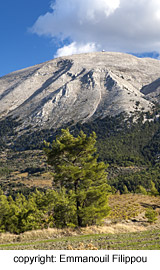 It is demanding because there is a big difference in altitude (750 meters).
It is demanding because there is a big difference in altitude (750 meters).
The most popular route starts from the south of village of Embona.
There are two alternative pathways that can become circular.
The most western one, easier but not marked, starts from a small dirt road next to a shrine, into a ravine, goes to southwest direction and then climbs over a rocky ridge. One goes on the dirt road leading to the wind turbines and follows up after the big turning point. From this point the trail has red marks. One follows back uphill, then downhill, meets the asphalt road leading to the radar on the peak and ends up climbing the ruins of the temple of Jupiter known as Jupiter of Attaviros on the side of the highest peak that is not accessible.
The second route starts from the end of the dirt road (fence and steps) initially moves to the side of a stream (a few red marks) and then without a path, either straight up a steep field or a curvy path that leads to a small valley below the top.
It is possible to make the ascent from the north edge of the village of Agios Isidoros there is a marked path to the wind turbines that comes and goes as above. Whatever route you follow ones should be equipped with the necessary clothes because even in summer the temperature difference is large and there is always a possibility of a fog. Also there is no well or source of water supply. The physiology of the soil is mostly rock and sand.
6. Archaeological site of the medieval moat
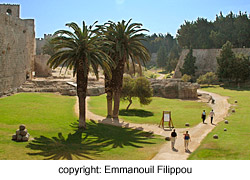 In the late 7th century AD, the ancient city of Rhodes because of the Arab Raid shrank. The medieval town was fortified gradually, taking its present form with the moat in the 16th century AD.
In the late 7th century AD, the ancient city of Rhodes because of the Arab Raid shrank. The medieval town was fortified gradually, taking its present form with the moat in the 16th century AD.
The total length of the medieval moat is 2300 meters and in several parts the width reaches 70 meters. It is a pleasant walk under bridges and medieval towers, bastions, in the centre of town and away from the hustle. It is a living monument literally, full of monuments and history. Admission is free to the public daily, 24 hours a day, all year round.
The entry-exit points are:
- From the port of Mandraki (behind the main taxi rank)
- Gate Akantias
- From the Kanonia Gate after Ag. Antoniou Gate
7. Walk of the walls
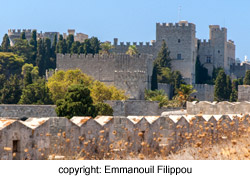 This route on the walls of the medieval city is 1100 meters long. Starts at the Kanonia Gate and ends at St. John’s Gate or Gate Koskinou, offering panoramic view of the medieval city of Rhodes.
This route on the walls of the medieval city is 1100 meters long. Starts at the Kanonia Gate and ends at St. John’s Gate or Gate Koskinou, offering panoramic view of the medieval city of Rhodes.
It offers a view of world heritage city, sacred and inspiring because thousands of young people fell in towns and sieges of Rhodes painting the walls with their blood.
The entry price and the timetable are set out by the Archaeological Service depending on the needs of each period.
8. Ancient Acropolis of Rhodes
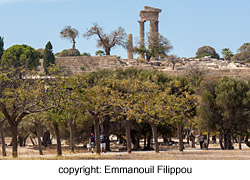 In the area of Ancient Acropolis of Rhodes where the Temple of Apollo, the ancient theatre and the ancient stadium there’s a rich grove of myrtles, laurels, oaks, pines and cypresses.
In the area of Ancient Acropolis of Rhodes where the Temple of Apollo, the ancient theatre and the ancient stadium there’s a rich grove of myrtles, laurels, oaks, pines and cypresses.
Among the trees there are several paths one can follow and enjoy nature with a backdrop of severe Doric lines of the landscape.
9. Hill Filerimos in Ialyssos
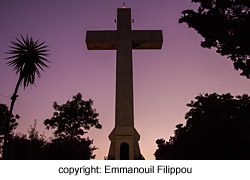 This route starts from the foot of the hill Filerimos it can be reached by following the western road (provincial road Rhodes – Kamiros) and turn left at the intersection of Ialysos where there is a relative sign “Filerimos Acropolis.” One arrives at the foot of the Hill, covering a distance of 1500 meters from the village. There is a water source with crystal clear water.
This route starts from the foot of the hill Filerimos it can be reached by following the western road (provincial road Rhodes – Kamiros) and turn left at the intersection of Ialysos where there is a relative sign “Filerimos Acropolis.” One arrives at the foot of the Hill, covering a distance of 1500 meters from the village. There is a water source with crystal clear water.
One begins the steep paved road through pine, oak and sage, to arrive after 2000 meters to the chapel of Young Prophet Elias and the Old Prophet Elias, where also there is a source with drinking water on our left. Following the same uphill enjoying the spectacular view of the bay and Ialysos.
Continuing, walking through the green landscape to a big square where there is a cafe beneath a huge oak tree. Up to this point it is accessible by vehicle and the total length, is 4000 meters.
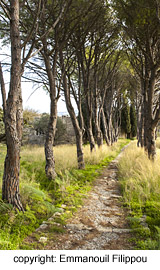 From this point only accessible on foot and continues for another 500 meters. Left, climbing 33 stone steps, one reaches the Acropolis of Ialysos and the Monastery of Our Lady of Filerimos. A little further, about 100 feet and descending 5 stairs, is the chapel of St. George of Hosti. Going right and passing through the pine Calvary with 14 stone representations corresponding to stops made by the Jesus Christ on the road of torture, one arrives at a square where the cross stands imposingly. Reconstructed in 1996 and has a height of 17.80 meters and 66 internal steps. Can simultaneously accommodate 25 guests. From there the view is unique.
From this point only accessible on foot and continues for another 500 meters. Left, climbing 33 stone steps, one reaches the Acropolis of Ialysos and the Monastery of Our Lady of Filerimos. A little further, about 100 feet and descending 5 stairs, is the chapel of St. George of Hosti. Going right and passing through the pine Calvary with 14 stone representations corresponding to stops made by the Jesus Christ on the road of torture, one arrives at a square where the cross stands imposingly. Reconstructed in 1996 and has a height of 17.80 meters and 66 internal steps. Can simultaneously accommodate 25 guests. From there the view is unique.
In the area there are many peacocks that give a special colour to the landscape. One can admire nature and relax in the tranquillity offered by the entire route. The scents emanating from the sage and other shrubs are intoxicating. Also from the end of January until the beginning of March you can find the wild cyclamen which grows in the region. The descent is done by the same route. It is of mild difficulty and the altitude is 247 feet.
10. Kallithea Springs
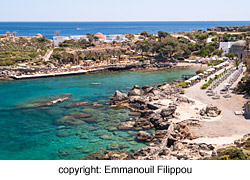 The Springs of Kallithea are located nine kilometers northeast of the city of Rhodes and three kilometers from the tourist resort of Faliraki. The healing of the springs was already known since ancient times and the era of the Knights. Today the area is popular because of its natural beauty with both locals and visitors there who celebrate Spring and Labour Day, especially those who reside in the surrounding area.
The Springs of Kallithea are located nine kilometers northeast of the city of Rhodes and three kilometers from the tourist resort of Faliraki. The healing of the springs was already known since ancient times and the era of the Knights. Today the area is popular because of its natural beauty with both locals and visitors there who celebrate Spring and Labour Day, especially those who reside in the surrounding area.
The area is pine forest with trails and paths, ideal for walks. Some of them end up in sandy bays and rocky shores which the sea has carved over the centuries.
To rest one can visit the monument of Kallithea Springs, one of the most popular destinations in Rhodes. In brilliantly organized facilities, houses at times, exhibitions and cultural events. It offers coffee, snacks and a beautiful beach.
11. Seven Springs
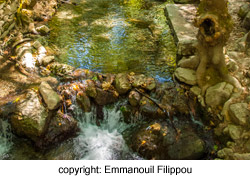 Taking the main road Rhodes- Lindos at the intersection of Archipoli. Two – three kilometres before the church of Agios Nektarios are the Seven Springs.
Taking the main road Rhodes- Lindos at the intersection of Archipoli. Two – three kilometres before the church of Agios Nektarios are the Seven Springs.Near the river with crystal clear waters of the seven sources are gravel paths suitable for walking.
There is a coffee shop and restaurant where visitors can relax and enjoy the nature. Visit the tunnel.
12. Apolakkia bay
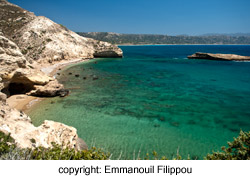 In the south near the village Apolakkia is the Apolakkia bay. It is protected by the Natura 2000 program due to the ecosystem: the dunes, a shrub called Agriokedrou and Caretta-Caretta turtle that lays its eggs in the area.
In the south near the village Apolakkia is the Apolakkia bay. It is protected by the Natura 2000 program due to the ecosystem: the dunes, a shrub called Agriokedrou and Caretta-Caretta turtle that lays its eggs in the area.
The season of autumn, the beach is filled with White Sea lily. Visitors can walk the sandy paths and dirt roads in the area of Fourni until the Limni.
In the chapel of St. George Kalamos one can rest and enjoy the view, especially the hours of sunset with the sun disappearing to the wild Karpathian Sea.
Editor: Seva Tsimbli
Translated by: Maria Mattsen- Kordina



